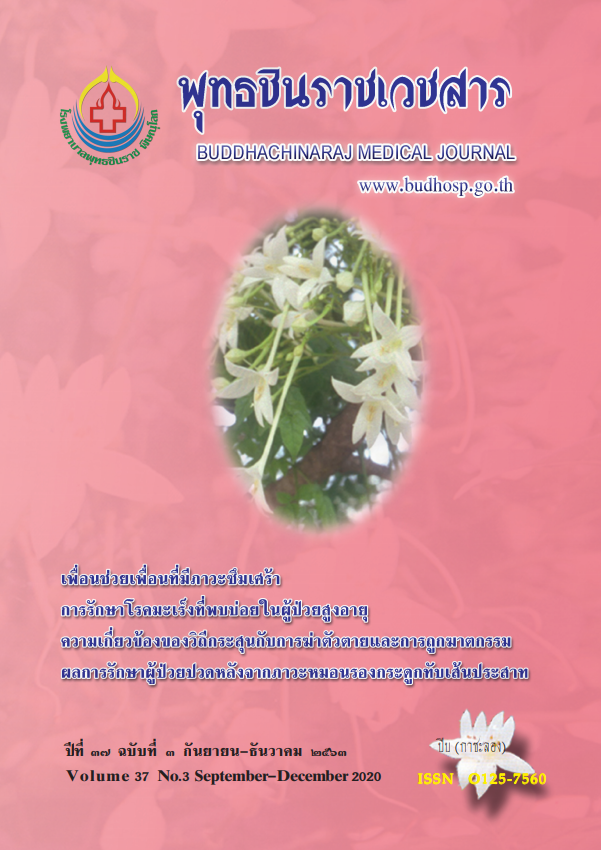ภาวะแทรกซ้อนหลังการปิดกะโหลกศีรษะระหว่างการปิดด้วยกะโหลกศีรษะผู้ป่วย และกะโหลกศีรษะเทียมในผู้ป่วยกะโหลกศีรษะแหว่งหลังการผ่าตัด เอากะโหลกศีรษะออกจากอุบัติเหตุ
ภาวะแทรกซ้อนหลังการปิดกะโหลกศีรษะ
คำสำคัญ:
การผ่าตัดปิดกะโหลก, กะโหลกศีรษะเดิม, กะโหลกศีรษะเทียม, การติดเชื้อหลังผ่าตัดในบริเวณ ที่ผ่าตัดบทคัดย่อ
การผ่าตัดเอากะโหลกศีรษะออกเป็นการผ่าตัดสำคัญที่ใช้ลดความดันในกะโหลกศีรษะและลดการกดก้านสมองเพื่อรักษาชีวิตผู้ป่วย ที่มีภาวะความดันในกะโหลกศีรษะสูง ประสาทศัลยแพทย์จำเป็นต้องผ่าตัดกะโหลกศีรษะออกเป็นบริเวณกว้างครอบคลุมบริเวณ ส่วน Frontal-Temporal-Parietal bone ทำให้เกิดภาวะกะโหลกศีรษะแหว่ง และเมื่อถึงเวลาที่เหมาะสมประสาทศัลยแพทย์จะ ผ่าตัดปิดกะโหลกศีรษะให้แก่ผู้ป่วย การศึกษานี้มีวัตถุประสงค์เพื่อเปรียบเทียบภาวะแทรกซ้อนที่เกิดในผู้ป่วยกะโหลกศีรษะแหว่ง จากอุบัติเหตุที่ได้รับการผ่าตัดปิดกะโหลกศีรษะด้วยกะโหลกศีรษะเดิมของผู้ป่วยกับกะโหลกศีรษะเทียมจากวัสดุสังเคราะห์ โดยศึกษาข้อมูลย้อนหลังจากการทบทวนเวชระเบียนผู้ป่วยที่เข้ารับการผ่าตัดในโรงพยาบาลพุทธชินราช พิษณุโลกระหว่างเดือนกรกฎาคม พ.ศ. 2556 ถึงเดือนมิถุนายน พ.ศ. 2562 พบผู้ป่วยทั้งหมด 91 คน เป็นผู้ป่วยที่ได้รับการปิดกะโหลกศีรษะด้วยกะโหลกศีรษะเดิม 31 คน (ร้อยละ 34.1) และผู้ป่วยที่ได้รับการปิดกะโหลกศีรษะด้วยกะโหลกเทียม 60 คน (ร้อยละ 65.9) พบภาวะ แทรกซ้อนหลังผ่าตัดปิดกะโหลกศีรษะทั้งหมด 11 คน (ร้อยละ 12) เป็นผู้ป่วยผ่าตัดด้วยกะโหลกศีรษะเดิม 8 คนใน 31 คน (ร้อยละ 28.5) และในกลุ่มกะโหลกศีรษะเทียม 3 คนใน 60 คน (ร้อยละ 5) และขณะเดียวพบการติดเชื้อของแผลผ่าตัดในกลุ่มกะโหลก ศีรษะเดิม 6 คนใน 31 คน (ร้อยละ 19.4) ซึ่งมากกว่า กลุ่มผู้ป่วยผ่าตัดด้วยกะโหลกศีรษะเทียมที่พบ 2 คนใน 60 คน (ร้อยละ 3.3) อย่างมีนัยสำคัญทางสถิติ สรุปได้ว่า การผ่าตัดปิดกะโหลกศีรษะด้วยกะโหลกศีรษะเดิมพบภาวะแทรกซ้อนหลังผ่าตัดมากกว่าการ ผ่าตัดปิดกะโหลกศีรษะด้วยกะโหลกศีรษะเทียม
เอกสารอ้างอิง
2. Jeyaraj P. Importance of early cranioplasty in reversing the "Syndrome of the Trephine/ Motor Trephine Syndrome/Sinking Skin Flap Syndrome". J Maxillofac Oral Surg 2015;14:666-73.
3. Cho YJ, Kang SH. Review of cranioplasty after decompressive craniectomy. Korean J Neurotrauma 2017;13(1):9-14.
4. Frassanito P, Fraschetti F, Bianchi F, Giovannenze F, Caldarelli M, Scoppettuolo G. Management and prevention of cranioplasty infections. Childs Nerv Syst 2019;35(9):1499-506.
5. Gooch MR, Gin GE, Kenning TJ, German JW. Complications of cranioplasty following decompressive craniectomy: analysis of 62 cases. Neurosurg Focus 2009;26(6):E9.
6. Nicola A, Francesca N, Matteo M. Cranioplasty:Routine surgical procedure or risky operation?. World J Surg Res 2016;5(9):22-33.
7. Northam W, Chandran A, Adams C, Barczak-Scarboro NE, Quinsey C. Cranioplasty length of stay: Relationship with indication, surgical decision-making factors, and sex. Trauma-England 2020;22(4):256-64.
8. Morton RP, Abecassis IJ, Hanson JF, Barber J, Nerva JD, Emerson SN, et al. Predictors of infection after 754 cranioplasty operations and the value of intraoperative cultures for cryopreserved bone flaps. J Neurosurg 2016;125(3):766-70.
9. Kim SH, Kang DS, Cheong JH, Kim JH, Song KY, Kong MH. Comparison of complications following cranioplasty using a sterilized autologous bone flap or polymethyl methacrylate. Korean J Neurotrauma 2017;13(1):15-23.
10. Zanaty M, Chalouhi N, Starke RM, Chitale R, Hann S, Bovenzi CD, et al. Predictors of infections following cranioplasty: a retrospective review of a large single center study. Scientific World J 2014; doi:10.1155/2014/356042.
11. Asano Y, Ryuke Y, Hasuo M, Simosawa S. Cranioplasty using cryopreserved autogenous bone. No To Shinkei 1993;45(12):1145-50.
12. Sundseth J, Sundseth A, Berg-Johnsen J, Sorteberg W, Lindegaard KF. Cranioplasty with autologous cryopreserved bone after decompressive craniectomy: complications and risk factors for developing surgical site infection. Acta Neurochir(Wien) 2014;156(4):805-11
13. Lemee JM, Petit D, Splingard M, Menei P. Autologous bone flap versus hydroxyapatite prosthesis in first intention in secondary cranioplasty after decompressive craniectomy:a French medico-economical study. Neurochirurgie 2013;59(2):60-3.
14. Brommeland T, Rydning PN, Pripp AH, Helseth E. Cranioplasty complications and risk factors associated with bone flap resorption. Scand J Trauma Resusc Emerg Med 2015;23(75):1-7.
15. Worm PV, do Nascimento TL, do Couto Nicola F, Sanches EF, Dos Santos Moreira CF, Rogerio LP, et al. Polymethyl methacrylate imbedded with antibiotics cranioplasty: An infection solution for moderate and large defects reconstruction? Surg Neurol Int 2016;7(Suppl 28): S746-S51.
16. Basheer N, Gupta D, Mahapatra AK, Gurjar H. Cranioplasty following decompressive craniectomy in traumatic brain injury: Experience at Level-I apex trauma centre. Indian J Neurotrauma (IJNT) 2010;7(10):139-44.
17. Singh S, Singh R, Jain K, Walia B. Cranioplasty following decompressive craniectomy-Analysis of complication rates and neurological outcomes: A single center study. Surg Neurol Int 2019;10(142): 1-7.
18. Goedemans T, Verbaan D, van der Veer O, Bot M, Post R, Hoogmoed J, et al. Complications in cranioplasty after decompressive craniectomy: timing of the intervention. J Neurol 2020;267(5):1312-20.
19. Sarsima S. Autologous graft and acrylate cranioplasty in skull defect patient in Yasothon Hospital. Reg 11 Med J 2014;28(3):643-8.
20. Heo J, Park SQ, Cho SJ, Chang JC, Park HK. Evaluation of simultaneous cranioplasty and ventriculoperitoneal shunt procedures. J Neurosurg 2014;121(2):313-8.
21. Posti JP, Yli-Olli M, Heiskanen L, Aitasalo KMJ, Rinne J, Vuorinen V, et al. Cranioplasty after severe traumatic brain injury: effects of trauma and patient recovery on cranioplasty outcome. Front Neurol 2018;9(223):1-7.
22. Cheng CH, Lee HC, Chen CC, Cho DY, Lin HL. Cryopreservation versus subcutaneous preservation of autologous bone flaps for cranioplasty: comparison of the surgical site infection and bone resorption rates. Clin Neurol Neurosurg 2014;124:85-9.






